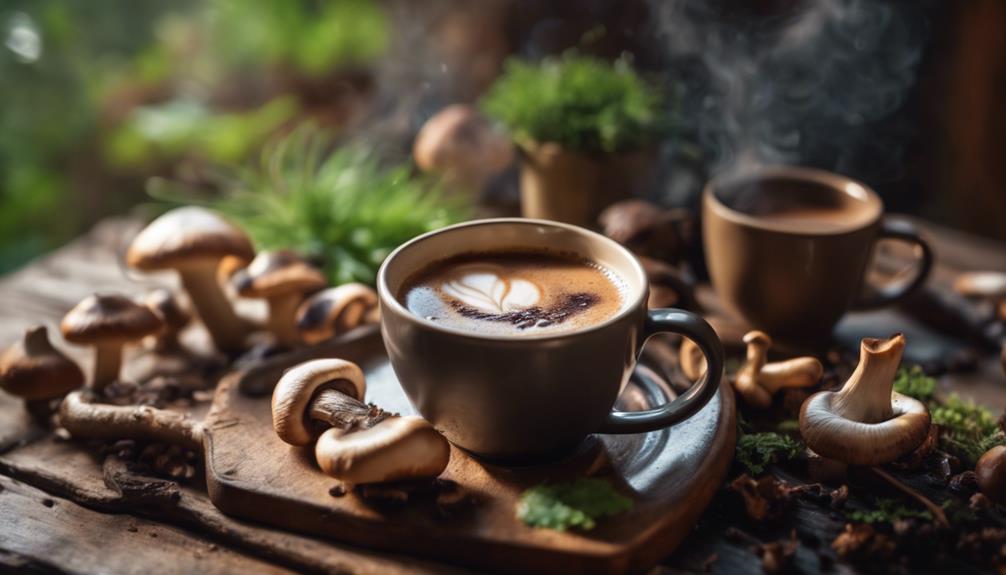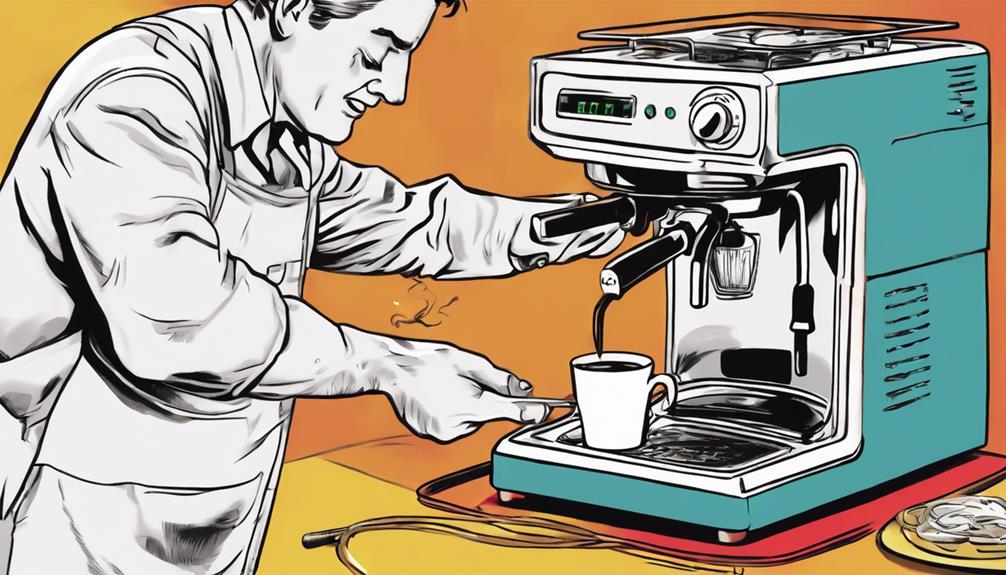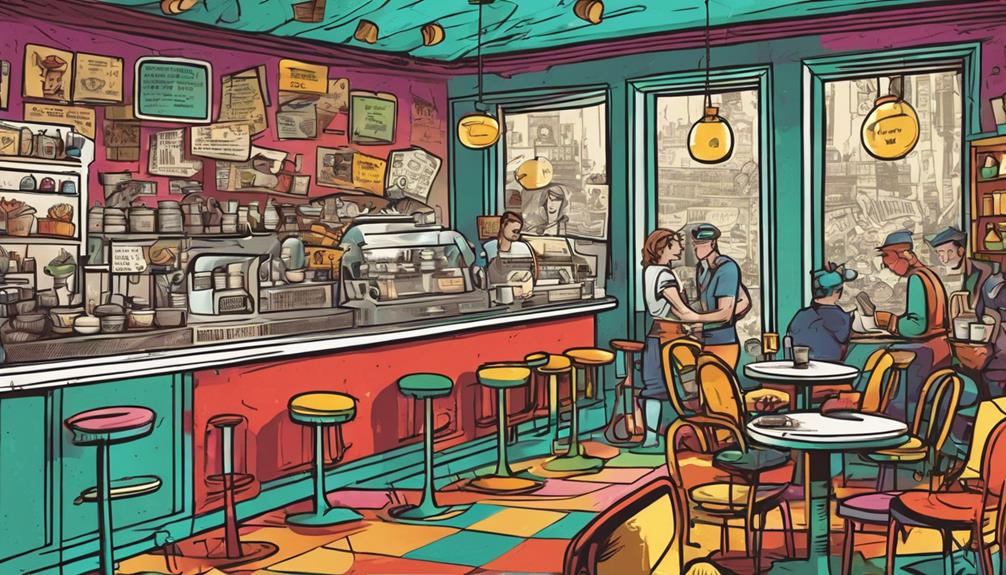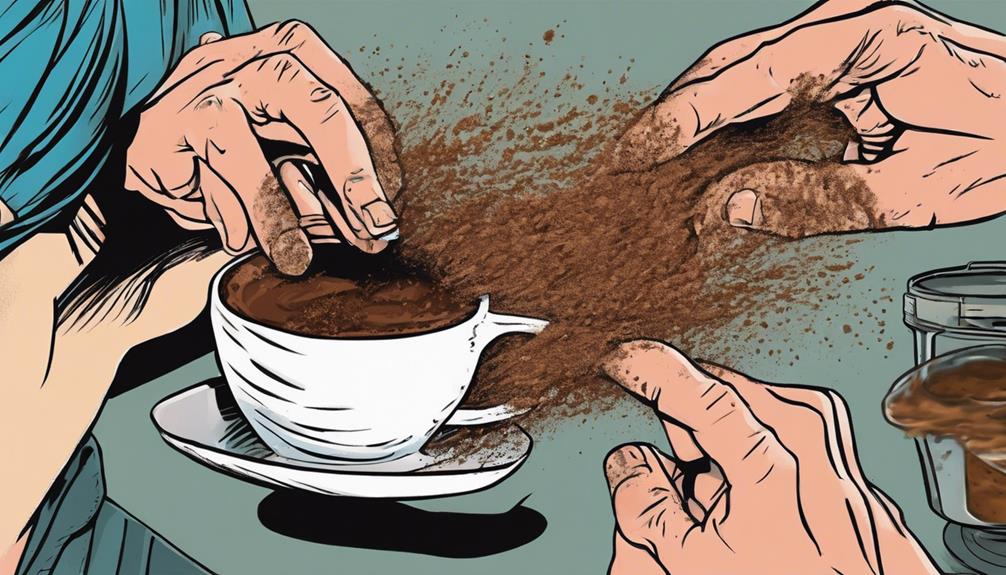To get the most out of your coffee’s flavors, concentrate on perfecting tasting techniques, honing skills, and grasping brewing factors. Dive into espresso techniques, cold-brew recipes, and a variety of brewing methods. For a culinary journey, pair your coffee with foods such as chocolate, vanilla, or cinnamon. Delve into different roasts and international coffee recipes to enhance your coffee experience.
Key Takeaways
- Identify coffee flavors: sweet, bitter, acidic, fruity, nutty.
- Experiment with different brewing methods for diverse tastes.
- Pair coffee with complementary flavors like chocolate or cinnamon.
- Adjust brewing variables for optimal flavor extraction.
- Use fresh, quality beans for the best coffee experience.
Coffee Tasting Essentials
To fully appreciate the nuances of coffee, you must first master the basics of coffee tasting. Start by ensuring you have a freshly brewed cup to experience the full range of rich flavors. Better coffee beans, such as Coffea arabica, often result in a sweeter taste compared to Coffea canephora. As you sip, identify different types of sweetness like fresh fruit, honey, caramel, or molasses to enhance your sensory experience.
Additionally, pay attention to the body of the coffee, which refers to its weight and feel on your tongue. The dose of coffee and the brewing method used can greatly impact the body. Acidity is another important aspect to take into account, as it adds brightness and dimension to your cup. Measure the quality of acidity by noting the perceived tartness and tanginess.
Developing a flavor vocabulary by associating coffee flavors with familiar foods can also help improve your tasting skills.
Practice and Improvement
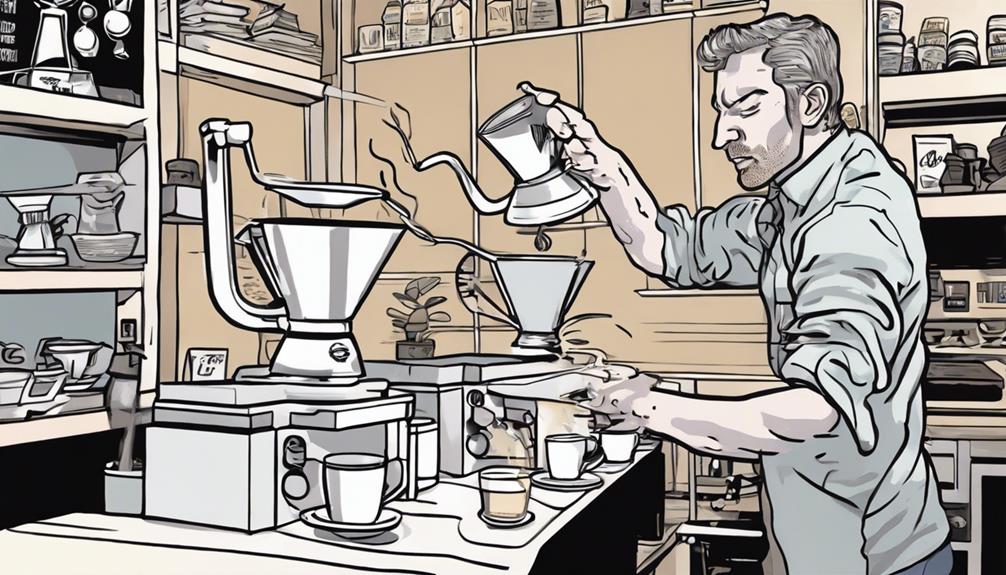
To enhance your coffee tasting skills, engage in regular practice and aim for continual improvement through various methods.
Daily consumption of coffee can help build your taste vocabulary and enhance your tasting skills over time.
Brewing different types of coffee for comparison is a great way to improve your ability to distinguish flavors and nuances in different brews.
Additionally, sharing a coffee tasting experience with a friend can be beneficial as it allows you to exchange tasting observations and broaden your coffee palate.
Remember that there are no wrong answers in coffee tasting; every experience is valuable for your growth.
By actively practicing and gaining more experience, you'll gradually improve your palate and develop a better understanding of your coffee preferences.
Utilizing the five taste categories to guide your impressions into words can also aid you in articulating the flavors you enjoy most.
Keep practicing, keep tasting, and enjoy the journey of continual improvement in your coffee tasting skills.
Factors in Coffee Brewing

How do different factors in coffee brewing impact the taste and quality of your brew?
When it comes to brewed coffee, the brewing method and various factors such as ground particle size, temperature, extraction time, and pressure play a vital role in determining the final flavor profile of your cup.
The size of the ground particles affects the extraction process, with smaller particles allowing for more surface area to be exposed to water, resulting in a more robust flavor.
Temperature is another pivotal aspect, with the ideal brewing temperature being just below boiling to extract the best flavors from the coffee grounds.
Extraction time also varies depending on the brewing method used; longer extraction times typically lead to a more intense flavor profile.
For espresso brewing, pressure manipulation is key, with around 9 atm of pressure needed to produce a good shot.
If you prefer cold-brewed coffee, be prepared for a longer brewing process, as it requires at least 72 hours in the fridge to achieve a smoother and less acidic flavor profile.
Espresso Brewing Techniques

When brewing espresso, controlling the pressure at approximately 9 atm is essential for a perfect extraction.
Adjusting the size of the coffee grounds finely impacts the flavor and texture of your espresso shot.
Let's explore these key points to master the art of making a rich and creamy espresso.
Pressure Control in Espresso
Mastering pressure management in espresso brewing is essential for achieving the desired mouthfeel and texture of your shot. Espresso brewing typically requires around 9 atm of pressure to extract the flavors efficiently. The level of pressure used during extraction significantly influences the final shot.
By manipulating pressure, you can customize your espresso brewing process to suit your preferences. Higher pressure settings result in a creamier texture as they facilitate increased oil extraction from the coffee grounds.
It's vital to understand that pressure control isn't the sole factor influencing the quality of your espresso. Alongside pressure, variables like grind size, temperature, and extraction time also play pivotal roles in shaping the flavor profile of your shot.
Experimenting with different pressure levels, in conjunction with adjusting these other variables, allows you to fine-tune your espresso to perfection. Remember, the interplay between these factors is what ultimately creates that perfect cup of espresso you desire.
Ground Size Adjustment
Optimizing espresso extraction and flavor involves adjusting the ground size to enhance the taste profile of your shot. The grind size plays a significant role in the extraction process; finer grounds increase the surface area, allowing for more flavor extraction, while coarser grounds can result in under-extraction. Finding the perfect balance is pivotal as a coarse grind may lead to a weak and sour shot, whereas a fine grind might bring out bitterness.
Your espresso's taste profile is directly impacted by the grind size, influencing the overall flavor experience.
To achieve the best results, experiment with different grind sizes until you discover the ideal one for your preferred espresso flavor. Remember, just like with a French press, where the coarseness of the grind affects the brew time and taste, adjusting the grind size for espresso can refine the nuances of your shot.
Take the time to fine-tune this aspect of your brewing process for a truly exceptional espresso experience.
Cold-Brewed Coffee Recipe

To make a delicious cold-brewed coffee, you'll need a few simple ingredients and follow easy brewing steps.
Cold brew typically involves coarsely ground coffee beans steeped in cold water for an extended period, resulting in a smooth and less acidic coffee concentrate.
Experiment with different coffee-to-water ratios and steeping times to find your perfect cold-brewed coffee strength and flavor profile.
Ingredients for Cold Brew
For cold brew coffee, you'll need coarsely ground coffee beans and cold water to start the brewing process.
To make the perfect cold brew, follow these ingredients and steps:
- Coarsely Ground Coffee Beans: Opt for a medium roast for a balanced flavor profile.
- Cold Water: Make sure to use cold or room temperature water for the brewing process.
- Brewing Ratio: Aim for a 1:4 coffee to water ratio for a concentrated flavor.
- Steeping Time: Allow the coffee to steep in the fridge for 12-24 hours for best extraction.
- Storage: Store the cold-brewed coffee in the fridge for up to two weeks for convenient daily consumption.
Brewing Process Steps
When preparing cold-brewed coffee, begin by combining coarsely ground coffee beans and cold water in a container. Let the mixture steep in the refrigerator for about 12-24 hours, depending on your preferred strength. Once brewed, strain the coffee using a fine-mesh sieve or a cheesecloth to remove the grounds.
Unlike hot-brewed coffee, cold-brewed coffee is known for its smooth, less acidic flavor profile. It can be served over ice or mixed with milk for a revitalizing drink. Cold brewing extracts the coffee's flavor compounds differently, resulting in a unique taste that many coffee lovers enjoy.
To enjoy a Vietnamese iced coffee, start by layering sweetened condensed milk at the bottom of a glass. Then add coffee grounds into a Vietnamese drip filter and pour hot water over them. Let the coffee drip over the condensed milk, creating a strong and slightly bitter brew.
Stir well, pour over ice, and savor the sweet, robust flavors of this delightful beverage.
Brewing Techniques for Coffee
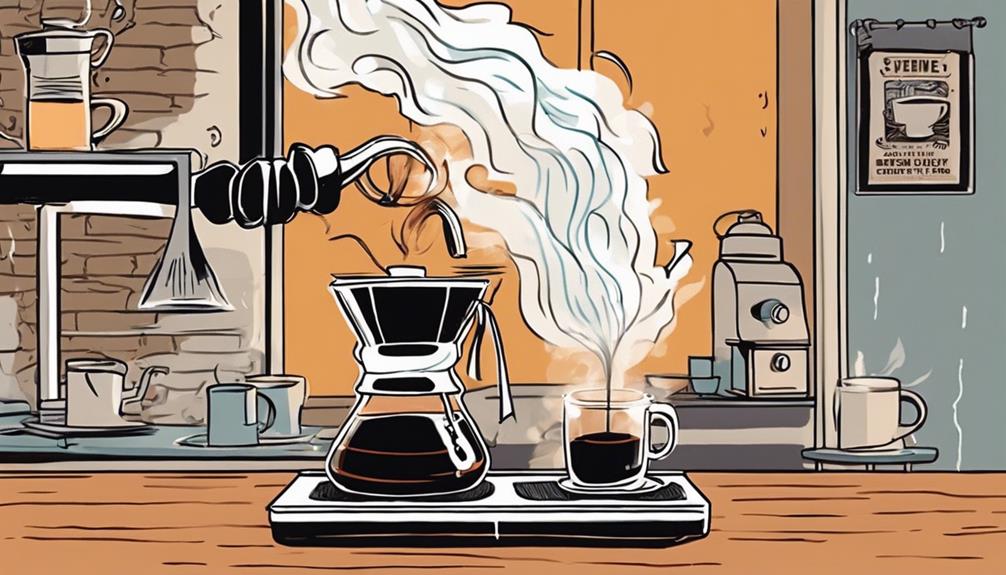
Ground particle size greatly impacts the extraction process when brewing coffee, influencing the final flavor profile of your brew.
To enhance your coffee experience, consider the following brewing techniques:
- Adjustable Grind Size: Experiment with different grind sizes to control the extraction process and tailor the strength and flavor of your coffee.
- Temperature Control: Keep the brewing temperature slightly below boiling point to achieve ideal extraction without introducing bitterness.
- Extraction Time: Longer extraction times can intensify flavors, so adjust based on your brewing method and the type of coffee beans you're using.
- Pressure for Espresso: Achieve the perfect espresso by ensuring a pressure of around 9 atm during the brewing process for a creamy texture and rich flavor.
- Cold-Brew Method: Enjoy a smoother flavor profile by cold brewing your coffee, allowing for a longer extraction period in cold water.
Food and Coffee Pairings

To elevate your coffee experience, explore the art of pairing food with different coffee flavors. Pairing complementary flavors can enhance the rich flavor profiles of your favorite coffee. Certain foods have the ability to balance the acidity, bitterness, or sweetness of your brew, creating a more enjoyable taste experience.
By experimenting with various pairings, you can expand your palate and deepen your appreciation for the intricate flavors of coffee.
Popular flavors like chocolate, vanilla, cinnamon, ginger, and caramel are excellent choices to pair with your coffee. These ingredients can add depth and complexity to your coffee-drinking experience, making each sip more satisfying.
Additionally, different types of coffee such as light, medium, and dark roasts each have their ideal food pairings. Matching specific foods with the right coffee roast can create a delightful and harmonious blend of flavors that will enhance your overall enjoyment of the beverage.
Best Flavors for Coffee Pairings
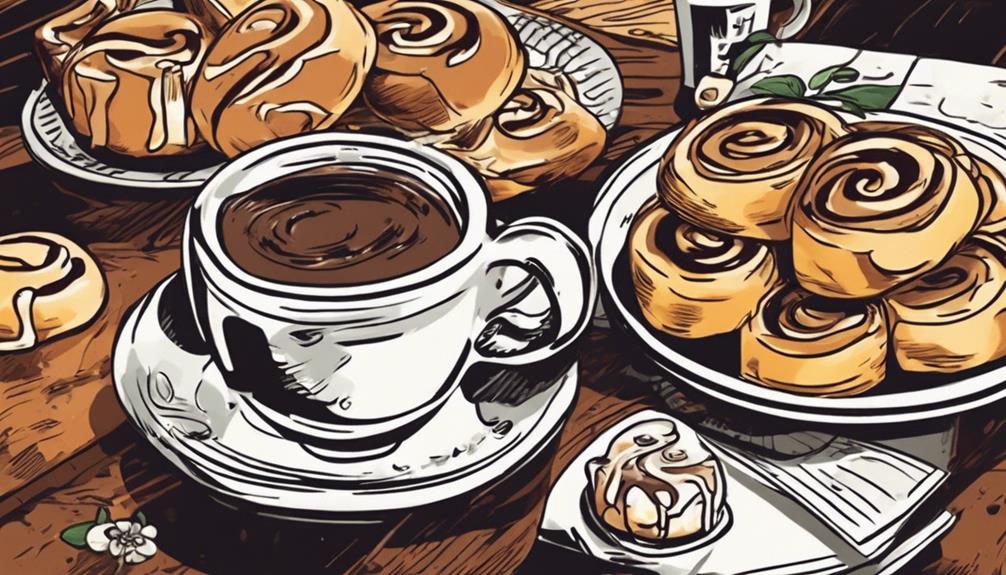
Exploring the best flavors for coffee pairings can greatly enhance your overall coffee-drinking experience. When selecting the perfect accompaniment for your cup of coffee, consider a blend of sweet and complementary flavors.
Here are some excellent options to elevate your coffee experience:
- Chocolate: Rich and decadent, chocolate pairs beautifully with most coffee varieties, adding a luscious depth to each sip.
- Vanilla: A classic choice, vanilla's creamy and sweet notes can enhance the natural flavors of your coffee, creating a harmonious blend.
- Cinnamon: Warm and aromatic, cinnamon adds a cozy touch to your cup of coffee, perfect for a comforting drink.
- Ginger: For a zesty kick, ginger can provide a unique flavor profile when paired with your favorite coffee, adding a hint of spice.
- Caramel: Sweet and buttery, caramel brings a delightful sweetness that complements the bitterness of coffee, creating a balanced and enjoyable combination.
Experiment with these flavors to discover your perfect coffee pairing and indulge in a delightful sensory experience.
Coffee Recipes Worldwide

Explore the diverse world of coffee recipes worldwide to expand your palate and discover new and exciting flavors. From the bold and creamy Vietnamese iced coffee to the frothy Turkish coffee brewed with sugar, each recipe offers a unique twist to the traditional coffee experience.
In Italy, indulge in the delightful contrast of flavors with a coffee affogato – hot espresso poured over rich, creamy vanilla ice cream for a decadent treat.
These coffee recipes showcase the creativity and diversity of cultures around the globe, bringing a touch of innovation to your daily coffee routine. Whether you prefer the sweet and creamy notes of Vietnamese coffee or the intense flavors of Turkish coffee, there's something for every coffee lover to enjoy.
Frequently Asked Questions
How Do You Get the Best Flavor Out of Coffee?
To get the best flavor out of coffee, start by using freshly ground beans and experiment with brewing methods. Adjust the water-to-coffee ratio for strength, consider roast level, and pair with foods for enhanced taste.
What Is the Best Way to Flavor Coffee?
To get the best flavor in your coffee, experiment with syrups, spices, or extracts. Mix it up until you find your perfect combo – vanilla, caramel, hazelnut, or cinnamon. Add natural twists like cinnamon sticks or orange peels for a unique taste.
How to Drink Coffee Like a Pro?
To drink coffee like a pro, focus on sweetness, body, acidity, flavors, and finish. Practice daily to enhance your taste skills. Experiment with brewing factors like grind size, temperature, and time. Master espresso nuances for a unique experience.
How to Properly Drink Coffee?
When you savor coffee, hold the cup by the handle, take small sips, and avoid stirring vigorously. Inhale the aroma first, then enjoy slowly. By following these steps, you can fully appreciate the rich flavors and aromas. For an even more authentic experience, enjoy black coffee and savor the natural flavors without diluting them with milk or sugar. This will allow you to taste the intricate notes of the coffee beans and fully appreciate the complexity of the brew. By taking the time to savor and enjoy black coffee, you can enhance your overall coffee-drinking experience.
Conclusion
Now that you've mastered the art of coffee brewing and tasting, you can truly savor the flavor with every sip. By understanding the intricacies of different coffee beans and brewing methods, you have unlocked a whole new level of appreciation for this beloved beverage. You may even want to consider becoming a coffee taster, with your newfound expertise allowing you to discern subtle notes and flavors that others may overlook. Embracing this passion for coffee tasting can open up new opportunities for you to share your knowledge and love for a good cup of coffee with others.
Like a symphony of flavors dancing on your taste buds, coffee is a delightful experience that can be enjoyed in so many different ways.
Keep experimenting, keep exploring, and keep indulging in the rich and complex world of coffee – you'll never run out of new and exciting ways to enjoy this beloved beverage.
Cheers to endless coffee adventures!

